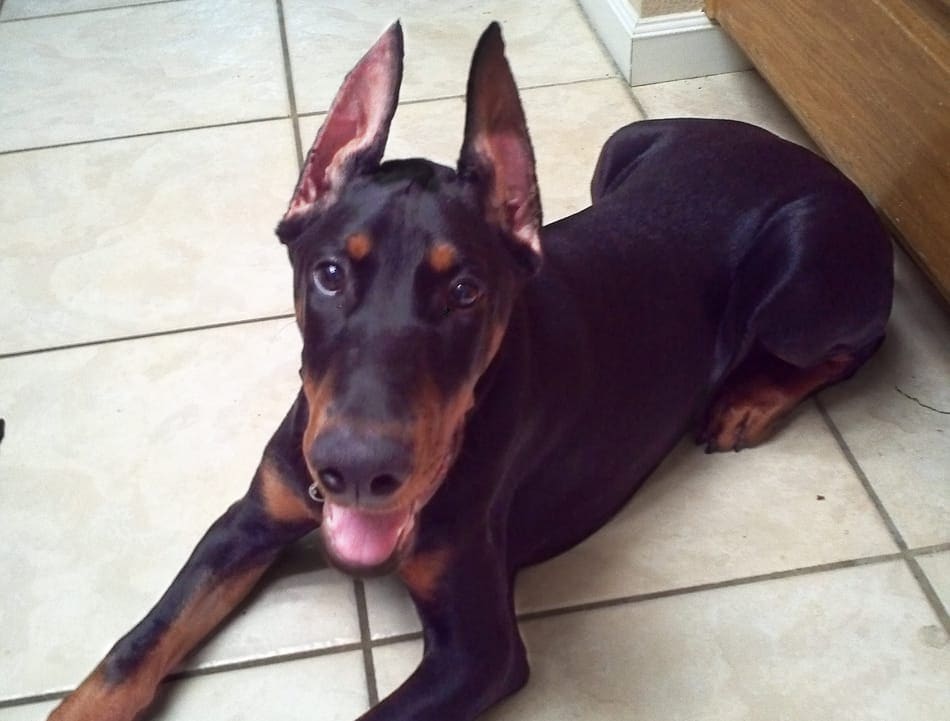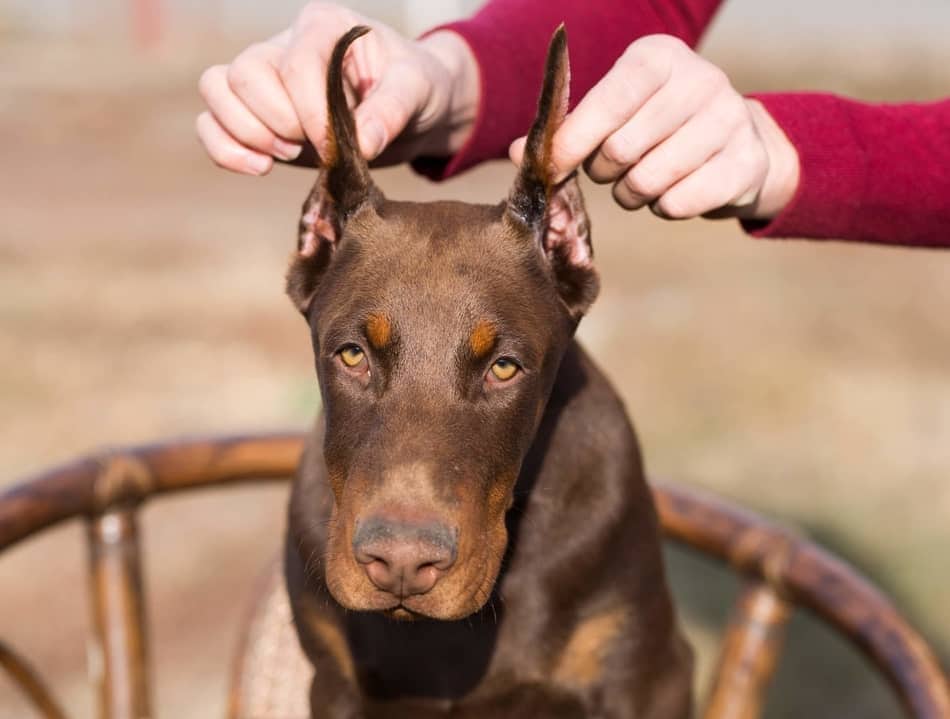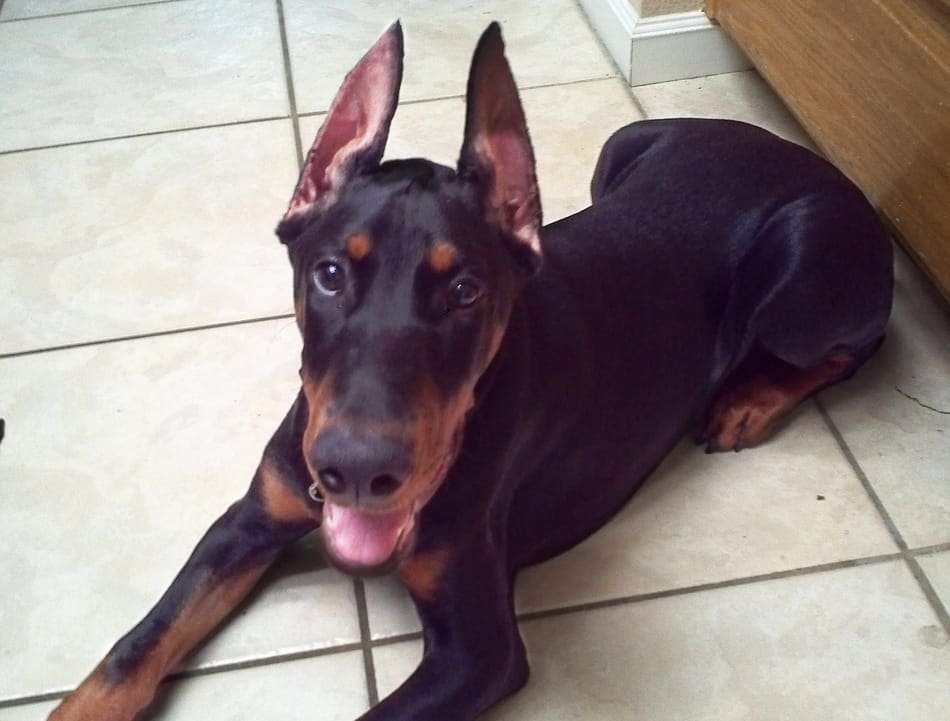Have you ever wondered if Doberman ears continue to grow after they are cropped? It’s a commonly debated topic among Doberman owners and enthusiasts. Some people believe that cropped ears will grow back naturally, while others argue that the cropped appearance is permanent. Let’s take a closer look at the growth and development of Doberman ears after cropping.
The practice of ear cropping in Dobermans has a long history. Originally, it was done for practical reasons, such as preventing injury during hunting and guarding activities. However, over time, it has also become a cosmetic procedure, giving the breed its distinctive alert and attentive appearance. While the cropping of Doberman ears is a personal choice and not a medical necessity, it is important to note that once the ears are cropped, they do not grow back. The shape and length of the ear will remain as it is post-cropping, resulting in the characteristic look that is often associated with Doberman Pinschers.
After cropping, Doberman ears may not grow to their natural length and shape. The cropping procedure involves removing a portion of the ears, which can affect their ability to grow properly. However, it’s important to note that the ears will still continue to grow to some extent after cropping. It’s crucial to follow proper aftercare instructions to ensure the best possible outcome for your Doberman’s ears.

Do Doberman Ears Grow After Cropping?
When it comes to Doberman Pinschers, one of the most distinct physical features is their ears. Historically, it has been common practice to crop the ears of Dobermans for aesthetic purposes. However, many people wonder if the ears will continue to grow after the cropping procedure. In this article, we will explore the topic of whether Doberman ears grow after cropping and provide detailed information on this subject.
The Cropping Procedure and Its Impact on Ear Growth
The cropping procedure involves surgically altering the shape of a Doberman’s ears. It is usually done when the puppy is around 8 to 12 weeks old. During the procedure, a veterinarian trims away a portion of the ear and then stitches it to create an upright and erect appearance. The cropped ears are then bandaged to aid in healing.
After the ears have healed and the bandages are removed, the ears will start to stand up on their own. However, it is important to note that the cropping procedure does not directly impact the growth of the ear itself. The surgery primarily affects the shape and positioning of the ear, but it does not prevent the ear from growing naturally.
As the Doberman grows, the ear will continue to develop and mature. The cartilage and tissues within the ear will naturally grow and adapt to the body’s growth. The cropped ears may appear slightly larger due to the change in shape, but this is not because the ears are still actively growing.
Factors That Influence Ear Growth
Several factors can influence the growth and development of Doberman ears after cropping:
- Genetics: The genetics of the individual Doberman play a significant role in ear growth. Some Dobermans may naturally have larger or smaller ears, which can affect how the cropped ears appear.
- Age: The age at which the cropping procedure is performed can impact ear growth. When the procedure is done on a younger puppy, there is more potential for the cartilage and tissues to adapt and develop as the dog grows.
- Aftercare: Proper aftercare is crucial for the post-cropping healing process. Following the veterinarian’s instructions and providing appropriate care can ensure optimal healing and minimize any potential complications that could affect ear growth.
The Advantages of Cropping Doberman Ears
While ear cropping has become a subject of controversy in recent years, there are still proponents of the procedure. Some of the perceived advantages of cropping Doberman ears include:
- Aesthetic Appeal: Many people find the cropped ear appearance to be visually appealing and distinctive, giving Dobermans a more alert and regal look.
- Ear Health: Cropped ears may have better air circulation, which can help prevent ear infections commonly experienced by dogs with floppy ears.
- Breed Standard: In some countries or for participation in certain dog shows, cropped ears are still considered a part of the breed standard for Doberman Pinschers.
Ethical Considerations and Alternatives
It is essential to consider the ethical aspects of ear cropping and make an informed decision. In many countries, the practice is banned or strongly discouraged due to concerns over animal welfare. Some alternatives to ear cropping that can help achieve a similar appearance include:
- Natural Ears: Allowing the Doberman’s ears to grow naturally without undergoing any surgical alteration.
- Faux Cropping: The use of specialized materials, such as foam or splints, to temporarily shape the ears and give the appearance of cropped ears without any surgical intervention.
- Show Braiding: In some dog shows, braiding the ears or using special clips to achieve an upright appearance can be an alternative to cropping.
Do Doberman Ears Grow After Cropping? – The Answer
In conclusion, after the cropping procedure, the Doberman’s ears do not actively grow in the sense of increasing in size. The growth primarily occurs during the puppy’s natural development, and the cropping procedure shapes the existing tissues. However, it is important to remember that ear growth can vary depending on genetic factors, age, and aftercare. Consider the ethical considerations and alternative options before deciding on ear cropping for your Doberman.
“Key Takeaways” for “do doberman ears grow after cropping?”
- Ear cropping is a surgical procedure performed on Doberman Pinschers to alter the shape and appearance of their ears.
- After cropping, Doberman ears go through a healing process and may appear shorter and smaller initially.
- The cartilage in Doberman ears does not grow back once it is removed during cropping.
- However, the skin around the cropped ears can stretch and the ears may appear to be taller as the puppy grows.
- The final size and shape of the ears after cropping depend on various factors, including genetics and the healing process.
Frequently Asked Questions
Here are some commonly asked questions about after cropping the ears of Doberman pinschers.
1. How long does it take for Doberman ears to heal after cropping?
The healing process for Doberman ears after cropping typically takes around 6 to 8 weeks. During this time, the dog’s ears will go through different stages of healing, including scabbing, scarring, and repositioning. It is important to follow your veterinarian’s aftercare instructions to ensure proper healing and minimize the risk of infection.
After the initial healing period, the ears will continue to mature and change slightly in shape over the next several months. The final appearance of the cropped ears may not be fully evident until around 6 to 12 months after the procedure.
2. Will the cropped ears of a Doberman grow back to their natural shape?
No, the cropped ears of a Doberman will not grow back to their natural shape. The cropping procedure involves the removal of a portion of the ear flap and reshaping the remaining tissue to create the desired appearance. Once the ears have healed, they will maintain the cropped shape for the dog’s lifetime.
It’s important to note that the cropping of Doberman ears is a cosmetic procedure and not necessary for the dog’s health or well-being. The decision to crop a Doberman’s ears should be made carefully and in consultation with a veterinarian.
3. Can the cropped ears of a Doberman be affected by the growth of scar tissue?
Yes, the growth of scar tissue is a natural part of the healing process after ear cropping. The formation of scar tissue can vary from dog to dog, and it may affect the appearance and texture of the cropped ears. In some cases, scar tissue can cause the ears to appear thicker or have a different texture compared to the surrounding skin.
Regular cleaning and maintenance of the cropped ears can help minimize the formation of excessive scar tissue. Your veterinarian can provide guidance on how to properly care for your Doberman’s ears to ensure they heal well and minimize the impact of scar tissue.
4. Is it necessary to tape or brace the cropped ears of a Doberman?
Taping or bracing the cropped ears of a Doberman may be recommended by your veterinarian to help support the healing process and promote the desired ear carriage. This is typically done during the initial healing period to encourage the ears to stand upright and prevent them from drooping.
The taping or bracing process involves using specialized materials to hold the ears in the desired position. It’s important to follow your veterinarian’s instructions and regularly monitor the ears to ensure the taping or bracing is effective and not causing any discomfort or irritation to your Doberman.
5. Are there any potential complications or risks associated with ear cropping in Dobermans?
Like any surgical procedure, ear cropping in Dobermans carries some risks. These can include infection, excessive bleeding, poor healing, and complications from anesthesia. It is important to choose a skilled and experienced veterinarian who follows proper surgical techniques and provides appropriate aftercare instructions.
Additionally, it’s important to consider the ethical implications of ear cropping and the legislation surrounding the procedure in your country or region. Some places have banned or restricted the practice due to concerns about animal welfare. Always research and consult with professionals before making a decision about ear cropping for your Doberman.

In summary, doberman ears do not grow after cropping. The procedure involves removing a portion of the ear, and the remaining tissue does not have the ability to continue growing.
It is important to note that cropping ears is a controversial practice with potential health risks. Many countries have banned or restricted the procedure due to concerns about pain, infection, and long-term complications.
